Issue #104, Volume #2


How To Earn Market-Beating Returns Without Taking Market Risk
This is Porter’s Daily Journal, a free e-letter from Porter & Co. that provides unfiltered insights on markets, the economy, and life to help readers become better investors. It includes weekday editions and two weekend editions… and is free to all subscribers.
| Porter’s Permanent Portfolio is up nearly 25%… Equity-like returns without matching risk… And if you invested with margin… A new portfolio coming at the Porter & Co. Annual Conference… Payroll numbers revised way, way down… Cash is not king… |
A year ago, I made our subscribers an absurd promise that I suspect most of you didn’t believe.
I told you there was a simple way to invest, a way that I’d learned from one of my wisest and most powerful mentors – a true Adler. Harry Browne taught me, 30 years ago, the greatest secret in all of finance: how to earn equity-like returns without taking equity risk.
Virtually every experienced investor and certainly every mainstream economist would tell you that’s impossible.
And I didn’t stop there. I also promised that by using this strategy:
You don’t have to buy and sell (or very rarely), and you don’t have to follow the news or worry about the future. The portfolio is structured in a way that makes it difficult – essentially impossible – to lose money, no matter what happens to the economy, or to individual stocks.”
This approach is perfect for retired investors, who must try to keep pace with inflation, while not being able to accept the volatility that normally accompanies investing in stocks.
It’s like setting a clock, once a year.
You’ve all been taught that these results aren’t possible. You’ve all been taught that to make big returns, you must take big risks. Those rules are framed by finance professionals as if they are laws of physics: they are inviolable, immutable.
But they aren’t.
Last year, I disclosed that, working on my own, I’d discovered several ways to massively increase the returns of this ultra-safe strategy – again, without increasing risk.
My version of Harry Browne’s incredible “Permanent Portfolio” not only provides equity-like returns without matching risks, my strategy produces market-beating returns, without any material increase in risk.
Over the last several Daily Journal essays, I’ve been trying to show you why these ideas work. I’ve told you a little bit about how I came to learn these strategies. They were developed, over hundreds of years, by a secretive group of uber-economists. These ideas are incredibly powerful because these strategies are powered by the massive ongoing manipulation of the currency.
In paper money regimes like the U.S., these ideas enable the practitioners of these strategies to acquire virtually unlimited amounts of capital.
I know that’s hard to believe. So I showed you how my personal portfolio (eight figures of securities) is up more than 90% year-to-date. And I showed you its incredible dynamics: nothing greater than average market risk, but with enormous outperformance, resulting in an almost unheard of Sortino Ratio in excess of 3.0 – a Sortino Ratio is a measure of return per unit of downside volatility.
These results shouldn’t be possible in a free market.
But our markets aren’t free. They are massively manipulated. And these strategies put those manipulations to work for you.
In trying to explain why all this works, I think I’ve lost most of you.
So, today I just want to show you the nuts and bolts of how you can apply these theories to produce vast amounts of wealth.
To prove all of this, last year, I laid out the entire theory and put it into practice for you – step by step. I didn’t merely suggest the basics of the strategy (balancing four different asset classes). I provided you with a complete blueprint, showing exactly how much of each investment to make, down to the exact number of shares to buy.
Here’s Porter’s Permanent Portfolio, which I unveiled it at my farm last fall during our Annual Conference.
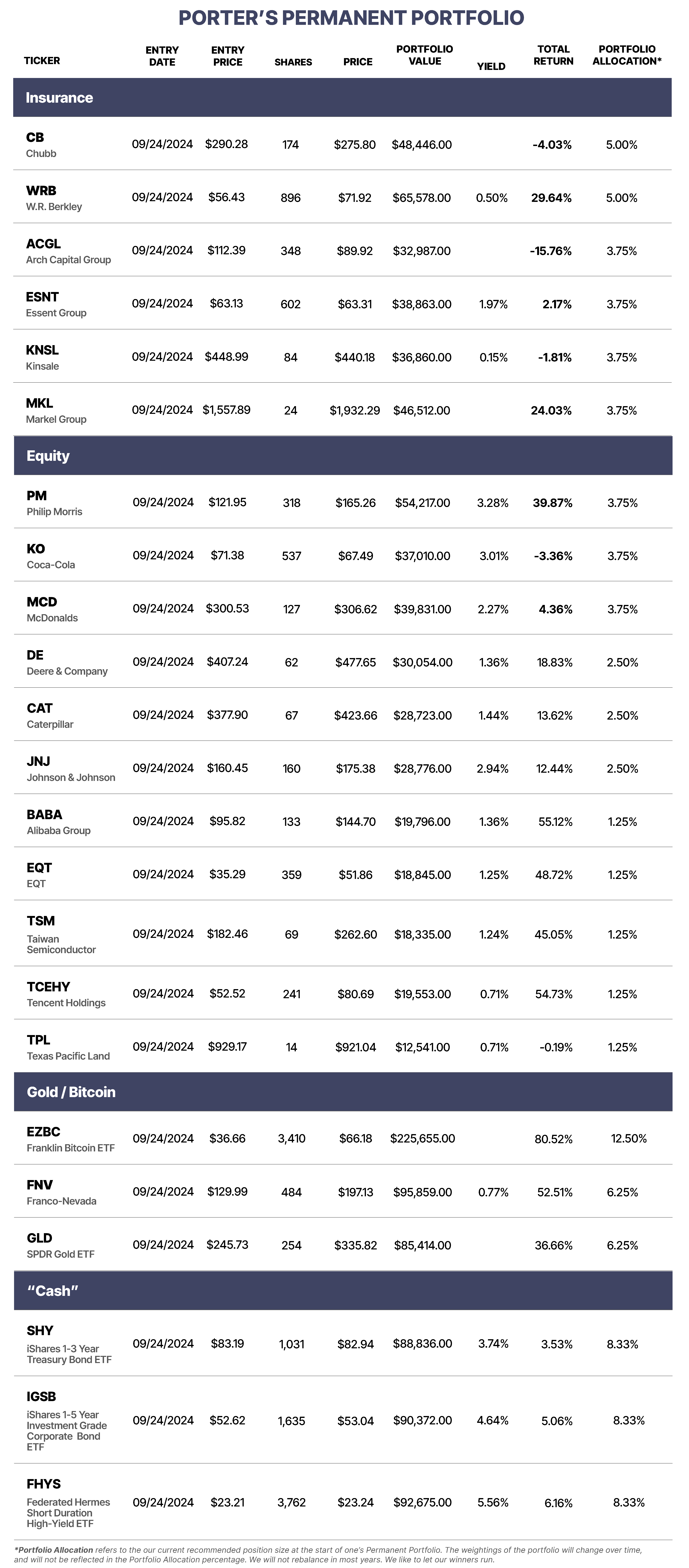
Our Permanent Portfolio is up 22.6% since it began trading on September 24, 2024. That’s roughly 2x the performance of the overall stock market during this period. And you should understand that this performance included a 25% allocation to cash!
That heavy cash allocation, along with the extremely low-risk investments in the portfolio, meant that the beta of our portfolio was only 0.50. Thus, Porter’s Permanent Portfolio was half as volatile as the stock market over the last year and produced double the returns.
The combination of strong returns and very low risk creates a Sharpe Ratio (that’s a measure of returns per unit of volatility) of almost 2.0 and a Sortino Ratio (again, that’s a measure of return per unit of downside volatility) of almost 3.0.
These kinds of results shouldn’t be possible.
Why does this work so well…?
Let’s look at each of the four components of the strategy.
Most investors focus on stocks. They believe, if they just knew which stocks to buy, they’d be successful. While that may be true in theory, in practice it’s virtually impossible to consistently have enough information to produce a substantial edge. The markets are very “efficient” in their ability to rapidly discount all available information.
But, yes, it’s important to do a good job as an investor. And if you look at the operating businesses we recommended as part of this strategy, we did a great job. Our operating company investments were up 20.5% – beating the market by a wide margin.
We produced those results in extremely safe stocks, too. The beta of the operating business investments was 0.69, resulting in a 1.60 Sharpe Ratio. That’s elite performance on par with the very best hedge funds and mutual funds in the world.
But that’s not what really powered our results.
Our best performing cohort was what we call the “real money” segment of our portfolio.
One of the major improvements I’ve made to Harry Browne’s strategy is investing in more efficient and more powerful ways to capture the ongoing currency manipulation. Harry died before Bitcoin was invented, but, no doubt, he would have recognized its incredible intrinsic value. Likewise, as an economist, Harry never really understood the gold streaming business model, which is, in effect, a highly leveraged way to invest in rising gold prices.
In Porter’s Permanent Portfolio, we allocated 25% of the fund into three forms of real money: gold, shares of gold-streaming company Franco-Nevada (NYSE: FNV), and Bitcoin. That portion of the portfolio is up 60%, with almost no volatility (beta: 0.53), producing an unworldly Sharpe Ratio (5.55) and a 8.50 Sortino Ratio.
Our 25% exposure to bonds, via our investments into property-and-casualty (P&C) insurance companies, was a laggard. That portion of the fund is only up 6.4%. As growth slows and interest rates decline, insurance companies will see their earnings growth decline.
And, obviously, our cash allocation was likewise an anchor, up only 4.8%.
The important thing to remember is that this portfolio is like a sail that’s propelled by the ongoing, massive inflation of our paper-money credit system. And, in that regard, it works. This strategy produced market-beating results with about half of the volatility of the stock market.
And that means, if you understand how to apply these strategies more aggressively, you can produce remarkable results. The low beta (0.5) and the large Sharpe ratio (over 2.0) means that you can successfully apply leverage to this strategy.
If you took this exact portfolio and, instead of holding 25% cash, you borrowed capital (margin) equal to your equity (2x leverage), and invested only in the three other segments (stocks, bonds, real money), your total return would have been almost 50% (47.9%) over the past year.
(This analysis assumes margin interest of 6%).
You’ve always been taught that margin is risky. And, of course, like some of our other trading strategies (selling puts), if you use margin in the wrong way, you’ll quickly regret it.
But think about it more carefully.
You’ve probably used margin responsibly many times in your life. Like when you buy a house. Or when you buy equipment at your business. There’s nothing wrong with using credit to buy assets that appreciate or using credit that provides you with more income than the borrowing costs.
I hope you’ll pay closer attention to this strategy going forward.
It’s called The Solution. Read more about it here.
We’re going to unveil a new, completely allocated Permanent Portfolio this year at our conference, on September 25.
If you want a fool-proof way to generate massive returns, I hope you’ll watch.
Partner Pass members have livestream access to the conference. You will receive an email with a link.
White House Insider Buck Sexton:
“Trump’s Next Move Will Shock The World”
It could single-handedly reshape the global order… dramatically increase U.S. power… and trigger a massive American market boom the likes of which we haven’t seen in 75 years.
Three Things To Know Before We Go…
1. The largest negative job revision on record. For the year ending March 31, 2025, the revision to non-farm payrolls came in at a loss of 911,000 jobs – worse than the previous record set in 2009 at negative 902,000. Nearly all of the downgrade was in the private sector, where hiring had been overstated by 880,000 jobs. The economy is slowing, the labor market is far weaker than expected, and rate cuts are coming next week.
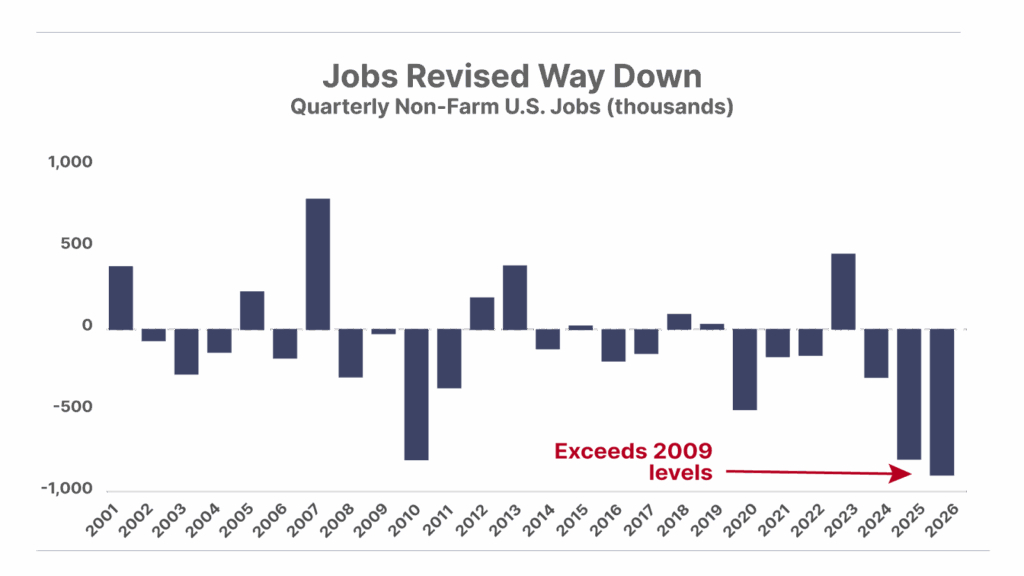
2. Producer price inflation unexpectedly declines in August. This morning, the Bureau of Labor Statistics reported that its producer price index (“PPI”) – a measure of the selling prices received by U.S. producers for their output – fell 0.1% last month, versus Wall Street expectations of a 0.3% increase. On a year-over-year basis, producer prices rose 2.6% versus expectations of 3.3%. Assuming tomorrow’s consumer price index (“CPI”) report doesn’t show higher-than-expectated consumer inflation, it’s all but guaranteed the Federal Reserve will cut interest rates by at least 25 basis points (“bps”) when it meets next week. In fact, if tomorrow’s report shows similar inflation weakness, it’s possible the Fed could cut by 50 bps.
3. “Mom and pop” are in love with cash. Cash plays a critical role in Porter’s Permanent Portfolio. Yet it’s a double-edged sword… holding too much cash in today’s inflationary paper-money world is a sure-fire way to lose purchasing power over time. And unfortunately, it appears many Americans are doing just that. According to a recent study from Fidelity Investments, cash is far and away the most popular “investment” among individual investors right now.
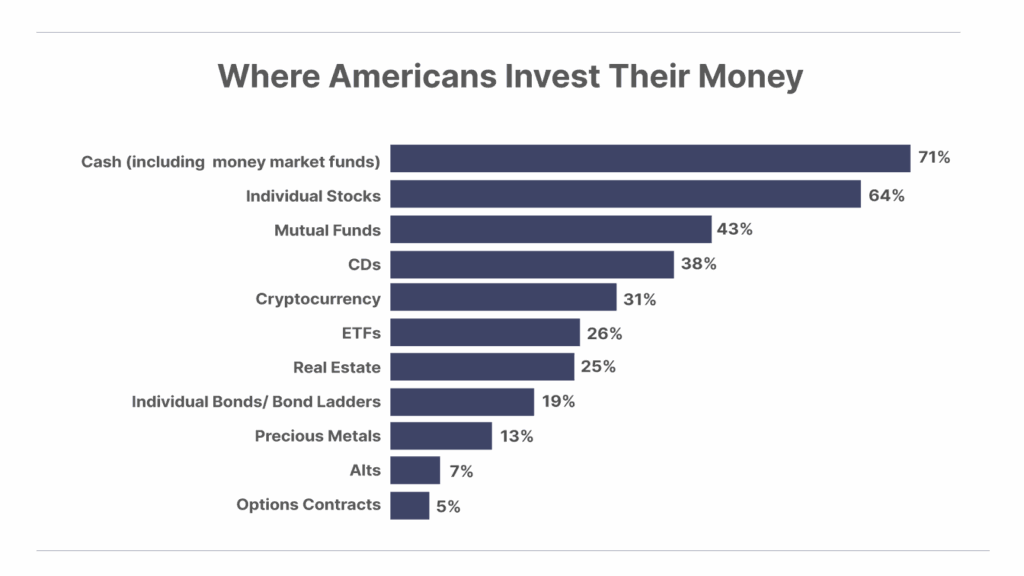
Tell me what you think: [email protected]
Good investing,
Porter Stansberry
Stevenson, Maryland
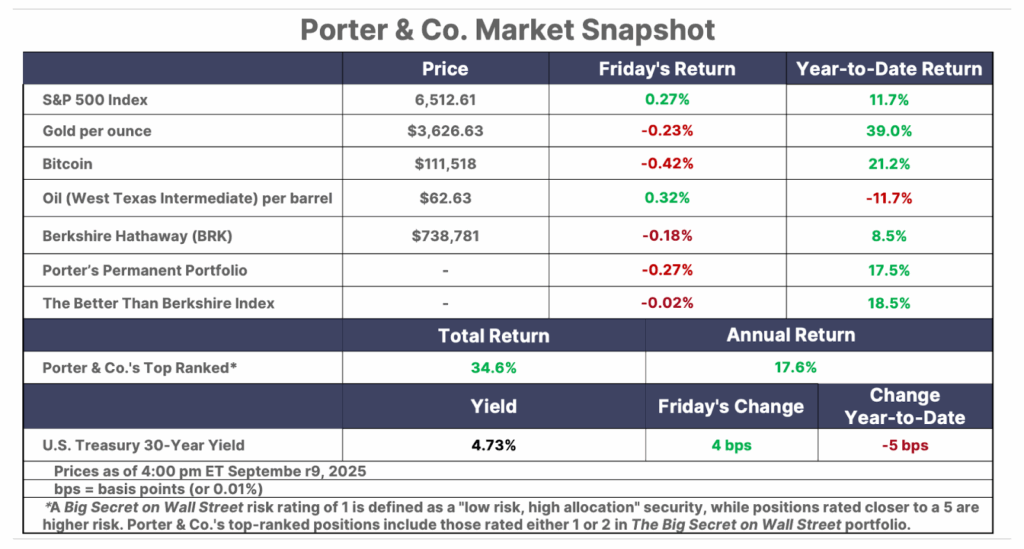
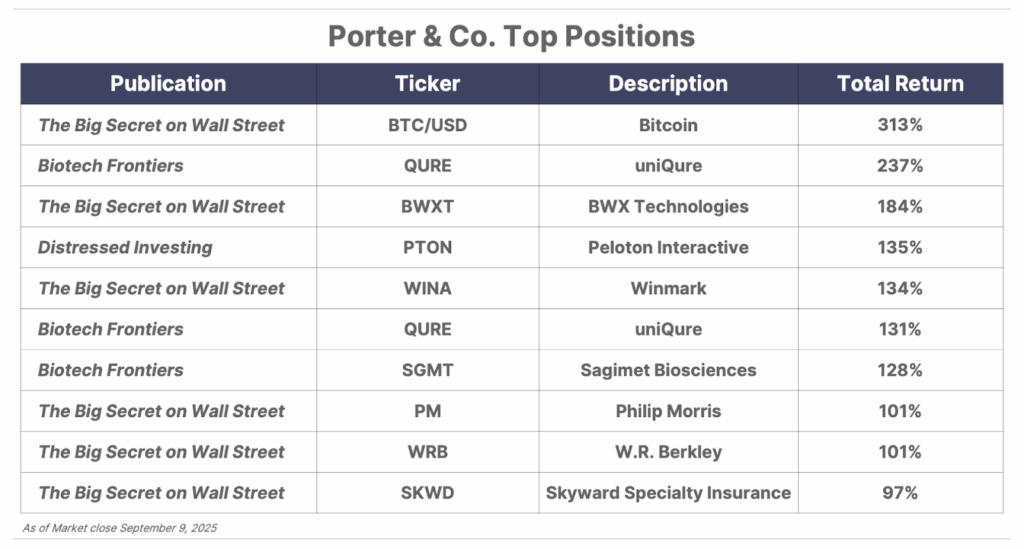
Please note: The investments in our “Porter & Co. Top Positions” should not be considered current recommendations. These positions are the best performers across our publications – and the securities listed may (or may not) be above the current buy-up-to price. To learn more, visit the current portfolio page of the relevant service, here. To gain access or to learn more about our current portfolios, call our Customer Care Team at 888-610-8895 or internationally at +1 443-815-4447.
